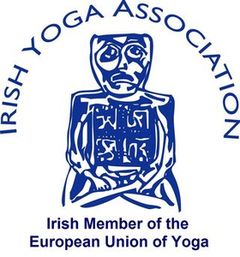Yoga Articles
Submitted by Colette Lee 07/01/2015
1. Savasana
Exploring Modifications in Savasana
How often in life do we give ourselves permission to lie still, relax and just breathe? The benefits of this quiet, purposeful resting pose should have us practising twice daily! When you have allowed tightness and tension to build up in the body, relaxing even when you lie down feels impossible. This is where a little preparation can help. Savasana is at its best, practised at the end of yoga class when the other active asana have stretched, opened and released tension in muscles. They also help to relax the diaphragm so we can breathe more freely.
Savasana is a lot more than just lying on the floor. It requires proper technique just as much as Adho Muka Svanasana or any of the other more active asana. Savasana’s success starts with location.
• Find a place that is quiet and somewhat dark, a place that is comfortable yet stable away from distractions.
• Have a light, warm blanket to cover the body as the body quickly cools down after asana practice. An eye bag or cloth to cover the eyes and block out light is helpful.
• Then comes the careful positioning of the body. If you feel uncomfortable in any part of the body, you may need support. Working with props to support one part of the body at a time can help you learn to consciously relax and refine your practise of Savasana.
SAVASANA WITH LEGS SUPPORTED ON CHAIR:
Elevating the legs will improve circulation, relaxes tired legs and releases tension in the back muscles (fig.1).
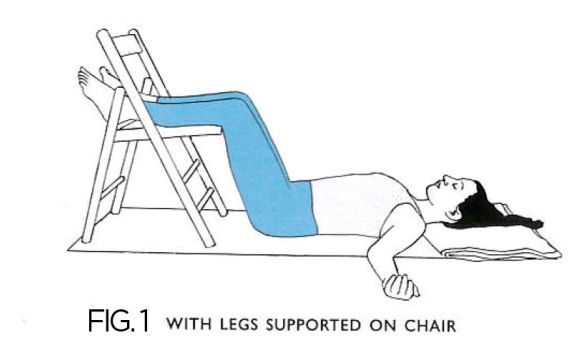
Lie in the centre of the mat and place the back of calves on the seat of chair, (ensure entire calf from back of knee to heel is supported equally).
Placing a blanket under the head and neck (all the way to the shoulders) keeps chin gently tilted downwards. Rest back of the arms on the floor palms facing up.
SAVASANA WITH UPPER BACK SUPPORTED:
Elevating the back and supporting the head (fig. 2) helps to open the chest, release the shoulders and helps the flow of the breath. If your mood is low this variation will be good for you.
Place a bolster or two folded or two folded blankets vertically along the centre of mat. Position the body over them, so they support from lower back to head. Place a folded blanket under your head and neck. Extend arms away from body and allow back of hands to soften and rest on the floor.
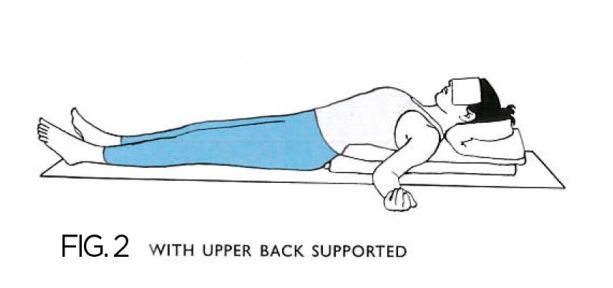
SAVASANA WITH SANDBAG:
To relax the abdomen and to settle the nervous system, place a sandbag or a few blankets horizontally across the abdomen/top of thighs, (fig.3) this works wonderfully to reduce lower back pain during menstruation.
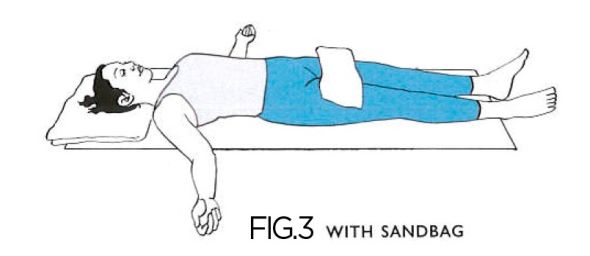
SAVASANA WITH HEAD WRAP:
Savasana can be done with a head wrap or an eye pillow placed over the eyes, (fig. 4). This helps to block out light and relax the pupils. It also helps to keep eyes as still as possible, resting in the back of their sockets. It sends a message to the brain to quieten and let go.
One way to gauge the time you spend in Savasana is to plan to stay at least 5 minutes for every 30 minutes you’ve practiced. Otherwise, enjoy this lovely pose for as long as you can.
Be guided into the full version of Savasana in the next issue.
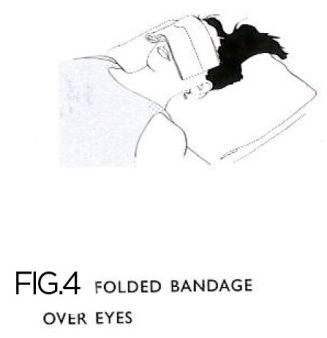
2. No Napping please – it’s Savasana
|
A prominent lawyer in Mumbai approached BKS Iyengar to find a time efficient yoga programme. She said to Iyengar, “I don’t have time to do a whole routine, what are the most important poses I need to do?” His answer was, “Two minutes Headstand, five minutes Shoulderstand and Savasana for as long as you can.” His inclusion of Savasana in this three –pose sequence suggests its overall importance. Although it looks easy, Savasana has been called the most difficult of the asana. Students who can balance, bend and twist through a class struggle with lying on the floor. It’s not uncommon for students to try and sneak out the door just as Savasana is beginning; they feel vulnerable lying still for 5 -10 minutes. Others see it as siesta time – time for a quick post-practice nap!! Savasana is not synonymous with napping; in fact it is just the opposite. At its best, Savasana offers an opportunity to experience the freedom that comes when you let go the ties that bind you to the external world. We allow ourselves to die a little bit, we let go of our endless worries and the to-do lists, and try to connect with the source of life within. |
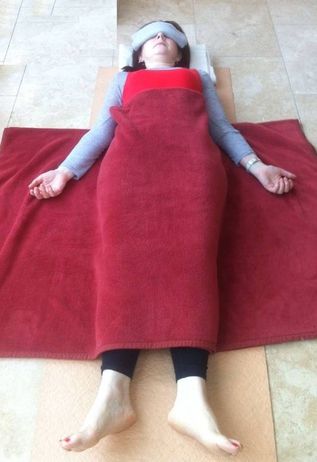 |
| The name of the pose could be one reason it’s misunderstood. “Corpse” is an unfortunate translation. To us in the West, this means a dead body. Indians have a different take on it. They see this “corpse” as being physically inert but very observant. That is the state that this pose can help us achieve – tranquil mindfulness. This period of deep relaxation allows you to step away from the ongoing conversation you have with yourself (monkey chatter), or whatever is going on in your life.Savasana is an important time for students to assimilate all the benefits from practicing asana. It allows a complete recharge and rejuvenation of the body. It is at this time you can start doing the real yoga. Savasana creates space to allow the integration of body, mind and spirit. We are used to engaging our muscles and our brains to achieve our goals; yet in Savasana, we must become equally skilled at letting go all activity in order for the poses beneficial effects to arise. It is hard to let go the idea that everything important happens when you are moving and taking action. Yet a deeper part of you waits for those moments when you are completely relaxed; to revel its truth. A feeling of connection, clarity or joy may arise from this state of ease and relaxation. | |
Next Issue: How to optimise you pose, A Savasana to die for! –
Exploring modifications of Savasana.
3. A Savasana to die for!
In the previous issues we explored the elements of the practice of Savasana. How working with props to support the body can help you learn to consciously relax and refine your practice. (Autumn 2014)
I enjoy that delicious rest at the end of class but it is only recent years that I have given it more serious consideration.
The following instructions may help your mind, body and breath to release deeply.
· Lie on your back and bring your body into as neutral position as possible.
Your brain experiences misalignment in Savasana as a disturbance, so the more you are able to bring yourself into balance the more your brain will quieten down.
· Allow the limits of your body to soften and dissolve, and using your mind, begin to consciously expand.
· Adjust your legs so that they are at equal angles from the midline drawn through your body; your heels only a few inches apart.
· Place your arms at your sides at a 45 degree angle to your body, palms facing up. Rest on the knuckle of the middle finger, so your little finger and thumb are equal distance from the floor.
· Move your head so your ears are equal distance from your shoulders. Rest on the centre of the back of the head, chin drawn slightly down towards the notch between the collar bones.
· Have the lips gently closed with the tongue resting on the floor of your mouth.
. Your tongue has its own midline so spread the tongue from the midline out equally on both sides.
· Drop your eyes towards the back of their sockets, with the gaze looking down into the body, into the heart centre.
· Soften your nose and deepen your ear canals so that you’re listening to the sound of your breath.
· Soften the skin over the cheeks and across the bridge of the nose. Allow the eyebrows to spread away from each other, creating space between them.
· Now imagine that you can feel your brain shrinking away from the skull, getting smaller and smaller and rebasing onto the back of your head.
· On your inhalation, receive the breath easily and effortlessly. On your exhalation, allow the breath to release gracefully.
For the next while it is important to stay as still and as present as possible. Allow the mass of your body to sink into the back of your body, sinking into your heels, your calves, your arms and the back of your head. Feel the connection to the floor below you and maintain an awareness of your breath. Be aware of the sounds from the room around you, to keep you rooted to the present throughout your Savasana.
You can judge the time you might spend in Savasana by allowing 5 minutes Savasana for every 30 minutes Asana practice. Otherwise, lie back and enjoy this delicious pose for 5-20 minutes.
Come out of Savasana as carefully as you went into it. Bring the breath deeper into the body. Bend the arms one at a time and rest them on the belly area. Bend the legs one at a time and rest the soles of the feet on the mat. When you are ready, roll onto your right side, tuck your knees in close to the body (The foetal position, the first asana you experienced in the womb).
When you feel ready, use your upper hand to push yourself up into a sitting position.
With the hands in the “Anjali” mudra, take a deep breath in to raise your head, bow your head to meet your heels.
Namaste
